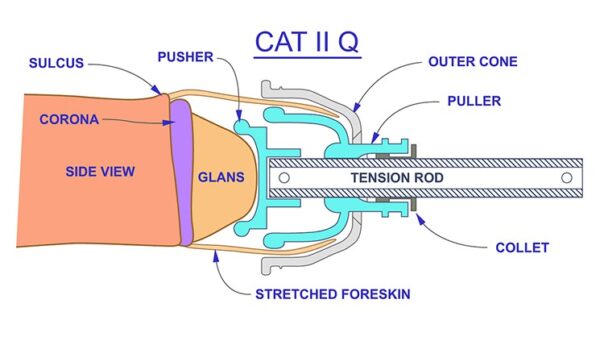Once you arrive at the clinic or hospital, you will be seen by a nurse who will ask questions about your health before performing a blood test and measuring your heart rate. You will also be asked to pay for your treatment.
The usual procedure for any surgery starts with signing a consent form. If you are a parent, then you will be asked to sign this form on behalf of your son unless he is old enough to answer them for himself. Once the formality of consent form is completed, then babies and young boys are usually given a local anaesthetic instead of a general anaesthetic as this is considered safer. This takes the form of a gel or injection into the penis. Older boys and adults are usually given a general anaesthetic. Furthermore, circumcision is performed as a ‘day case’, which means that you or your son can return home on the same day. The procedure is quick and takes about 30 minutes on average
Additionally, there are two types of circumcision surgical techniques, which are employed in this kind of surgery:
- Traditional (forceps)
The use of forceps to remove the foreskin is the traditional approach to circumcise a penis. Experts from Circumcision Center have remarked that this technique is now being used for older boys and adult males.
The surgeon uses a pen to mark the area to be treated before an incision is made. The foreskin is pulled back in front of the glans before being cut away with a scalpel. The forceps are used to help guide the scalpel. Blood vessels are sealed using electrical currents via a technique called ‘bipolar diathermy’.
This clean cut is then closed with stitches or a special type of glue. These will be either the dissolvable or non-dissolvable stitches. If you have non-dissolvable stitches, then you will need to return to the clinic at a pre-arranged date to have them removed.
A paraffin-based surgical dressing is wrapped around the penis. This is designed to prevent your wound from rubbing against your underwear. It also reduces any swelling. Wearing tight briefs will provide extra support.
- Plastibell
Developed and mastered in the last decade of 20th century, this technique does not need cutting or surgical insertions. This method involves using a small plastic ring which is fitted around the glans and then tightened. This compression blocks the blood supply to the foreskin. The foreskin then dies and falls off with the plastic ring after a couple of weeks. Experts have remarked that this plastibell procedure is usually performed on babies and young boys.
- Traditional vs. Plastibell: which is better?
The fact is that both (traditional and plastibell) are two different methods of achieving the same results. However, the similarities between them end right there, where one employs surgical removal, the other does not require any such particular cutting of the skin.
The traditional procedure gives an instant result, but it does involve the patient having stitches and wear a surgical dressing. (But this is a temporary measure and the wound usually heals within a week). And as mentioned earlier this technique is applied to in Adult Male Circumcision surgeries.
The advantage of the plastibell procedure is that the baby can be changed and bathed straight away as there are no stitches or dressing to deal with. However, you generally to have to wait for a few days to see the results of this procedure, which means after the plastic ring has fallen off.
And let’s not forget, no matter how successful their results might be, a medical surgery has a slight chance of complication. So it is better to know how to properly take care of the wound after the surgery to avoid any such problem.
- Care after surgery
Once you have recovered from general anaesthesia, you will be able to return home. The surgeon will advise you about the proper Adult Circumcision Care and will also prescribe a few medicines, which might include painkillers and antibiotics.
- Keep the dressing on for a period, as advised by your surgeon. Soak it and then remove it. Once removed, wash away dried blood from your penis and gently pat dry it before applying a fresh dressing.
- It is recommended by many experts to apply Vaseline on your penis before dressing, as this will prevent it from sticking to the wound.
- Keep repeating this procedure for a couple of days.
- Do not use any antiseptic cream, as it could potentially disrupt the healing phase
- Apply Vaseline on the tip of your penis before you urinate, as it will help in lessening the burning sensation
- If you have dissolvable stitches, then these will disappear on their own. The other type of stitches will have to be removed after a couple of weeks.
- Make sure you get plenty of rest during this time.
- Avoid unnecessary movement or walking around too much as this will put a strain on the circumcised wound.
- Avoid sports and exercise until your circumcision wound has healed. The wound typically heals in about 7 to 10 days in babies but can take up to three weeks in older boys and men.
- Avoid sexual activity for six weeks following surgery until you are fully healed.
- Risks and complications
Surgery is safe, but no procedure is 100% risk-free. Complications are rare, but they do happen, and it is as well to be aware of these.
This includes:
- Too much bleeding or infection in the area
- An awful lot of skin removal
- Side effects from medicines or methods being used to achieve the desired results.
- Damage to the urethra which causes it to narrow and impede the flow of urine.
- Abnormal scar tissue which may need further surgery to correct.

